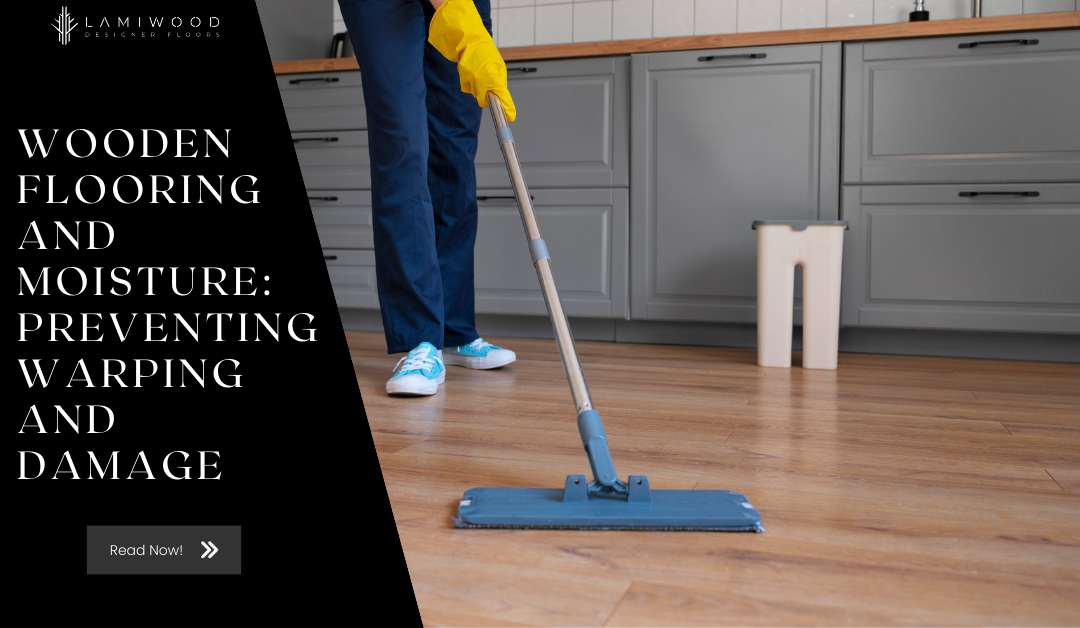While wooden flooring is a durable and low-maintenance option for many homes, it can be susceptible to moisture damage if not properly installed or maintained. Exposure to water, humidity, or other sources of moisture can cause wooden flooring to warp, buckle, or delaminate, leading to costly repairs or replacements. Let’s explore the relationship between wooden flooring and moisture, and share tips for preventing warping and damage in your home.
Understanding Moisture and Wooden Flooring
Wooden flooring is made up of multiple layers of materials, including a high-density fiberboard (HDF) core, a printed design layer, and a clear protective wear layer. While these layers are designed to resist moisture to some extent, they are not completely waterproof and can be affected by exposure to water or humidity over time. Here are some of the ways that moisture can affect wooden flooring:
- Warping: When wooden flooring absorbs moisture, it can cause the planks to expand and contract, leading to warping or unevenness in the floor.
- Buckling: If moisture gets trapped beneath the wooden flooring, it can cause the planks to buckle or lift from the subfloor, creating a tripping hazard and damaging the floor.
- Delamination: Exposure to moisture can cause the layers of wooden flooring to separate or delaminate, leading to gaps, cracks, or other damage.
- Mold and mildew: If moisture is allowed to sit on or beneath wooden flooring for an extended period, it can lead to the growth of mold and mildew, which can be harmful to your health and damage the floor.
Preventing Moisture Damage to Wooden Flooring
To prevent moisture damage to your wooden flooring, it’s important to take a proactive approach to installation, maintenance, and moisture control. Here are some tips for keeping your wooden flooring dry and damage-free:
- b ture barriers: In areas prone to moisture, such as basements or bathrooms, it’s a good idea to install a moisture barrier beneath the wooden flooring. This can help prevent moisture from seeping up from the subfloor and damaging the flooring.
- Spill protection: To prevent water damage from spills or leaks, it’s important to clean up any liquid on the wooden flooring promptly. Use a dry or slightly damp cloth to blot up the spill, and avoid using excessive water or cleaning solutions that could damage the laminate flooring.
- Humidity control: To prevent moisture damage from humidity, it’s important to maintain a consistent humidity level in your home, ideally between 35-55%. Use a dehumidifier in damp areas, and avoid installing wooden flooring in areas with excessive humidity, such as saunas or steam rooms.
- Regular maintenance: To keep your wooden flooring looking its best and prevent moisture damage, it’s important to follow a regular maintenance routine, including sweeping, vacuuming, and occasional damp mopping with a well-wrung mop. Avoid using excessive water or harsh cleaning products that could damage the flooring.
What to Do if Moisture Damage Occurs
If you do notice signs of moisture damage to your wooden flooring, such as warping, buckling, or delamination, it’s important to act quickly to prevent further damage. Here are some steps to take:
- Identify the source of the moisture: Look for any leaks, spills, or other sources of water that may be causing the damage, and address them promptly.
- Dry the area: Use fans, dehumidifiers, or other drying methods to remove any standing water or moisture from the affected area.
- Inspect the damage: Assess the extent of the damage to your wooden flooring, and determine whether it can be repaired or needs to be replaced.
- Contact a professional: If the damage is extensive or you’re unsure how to proceed, contact a professional flooring installer or restoration company for assistance.
Conclusion
While wooden flooring is a durable and low-maintenance option for many homes, it’s important to be aware of its relationship with moisture and take steps to prevent warping and damage. By following proper installation and maintenance guidelines, using moisture barriers and humidity control, and acting quickly if moisture damage occurs, you can keep your wooden flooring looking beautiful and damage-free for years to come. Remember, prevention is key when it comes to protecting your adorable wooden flooring from the damaging effects of moisture. So go ahead and take proactive steps to keep your floors dry, healthy, and beautiful – your adorable home (and your peace of mind) will thank you!

